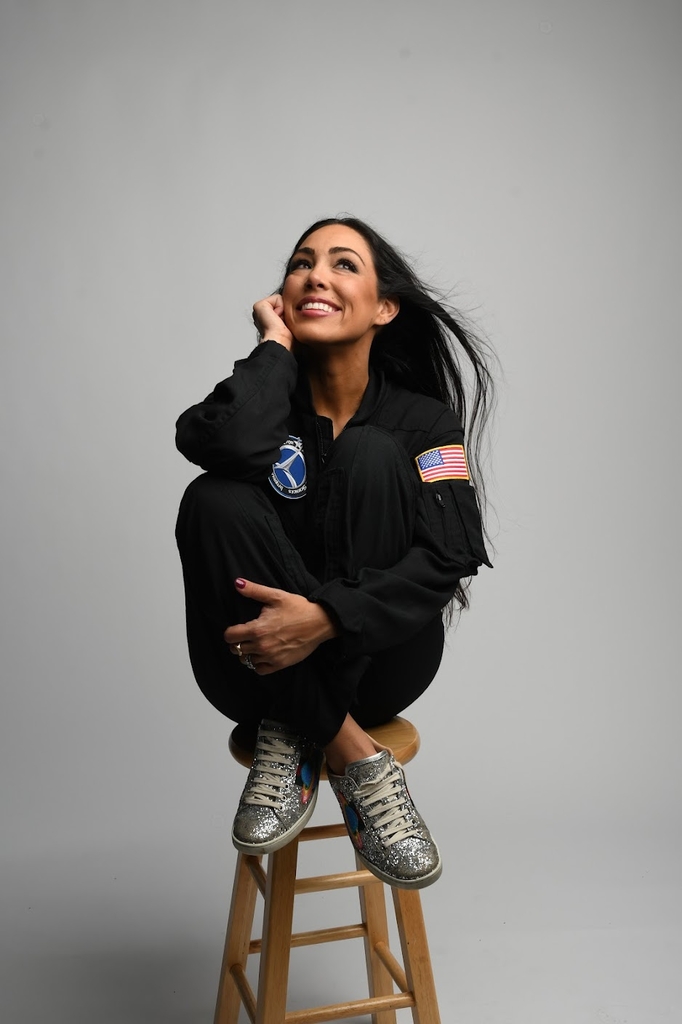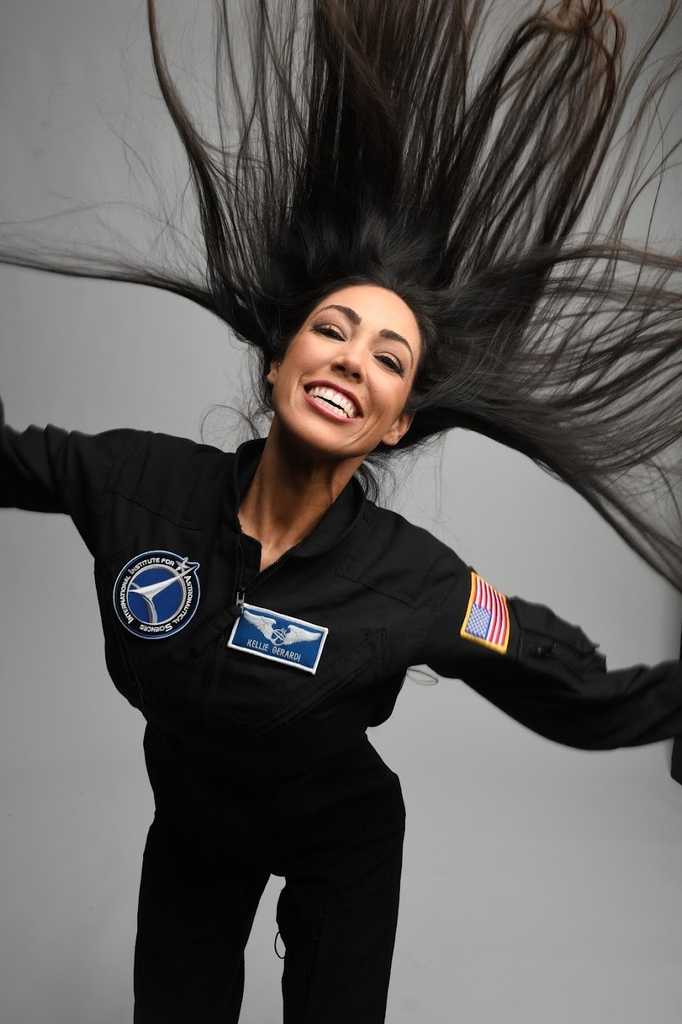If you were one of those young women who dreamed of becoming an astronaut when you grew up, you will swoon to meet Kellie Gerardi, who has done all that and more. In a talk with Playboy, Gerardi tells us the story of her career, navigating past the skeptics and naysayers, and why she wrote a book to encourage young women to pursue dreams that could take them to the stars.
Playboy: Children often dream of becoming astronauts. Was this true for you too, or did that dream begin to form at a later date?
Gerardi: Flying to space was alway in the back of my imagination. I grew up in Jupiter, Florida (very on-brand for someone with my particular passions) and from an early age, I was able to watch launches right up the coast here in Florida. That early exposure to human spaceflight felt like having front row seats to the final frontier, and looking back, I think it made a pretty powerful impression on me. Then as a young adult, I watched the early emergence of a commercial spaceflight industry, and I knew then that I wanted to be a part of democratizing access to space for the next generation. As a young professional, I was particularly motivated by microgravity research. I studied with the International Institute for Astronautical Sciences and became a bioastronautics researcher, and eventually a payload specialist, trained to operate specific scientific experiments in space.
Playboy: You’ve said on social media that you faced a lot of skeptics about your dream to become an astronaut. How did you navigate through that?
Gerardi: I’ve always been an evangelist for the commercial spaceflight industry — from day one, I have truly believed in the power of this industry to democratize access to space and expand Earth’s economic sphere. So to me, flying to space was always a “when” and not an “if.” I projected that confidence boldly and publicly, declaring my dream and intentions out loud many years before a concrete path emerged. Naturally, there were skeptics; this is all pretty new territory and my flight was the first time an industry-sponsored payload specialist had been contracted to fly on a commercial spacecraft. But when you have a big, audacious dream, you have to tune out all the noise and be your own biggest champion. To this day, I still believe my unwavering confidence in myself helped set the tone for the confidence other people came to have in me.
And then of course I worked my ass off to make sure I proved the doubters wrong; being underestimated and the promise of proving someone wrong can be incredibly powerful motivation. And honestly, I thought the skeptics just lacked vision and imagination. There was never ego like “obviously I’ll go to space,” it was much more a genuine and quieter confidence of, “well, if I work hard enough, why not me?” In my mind, the limiter to human spaceflight has always been access, not aptitude. It’s an honor to walk through that door, but the bigger goal is now holding it open even wider for the next generation of researchers.

Playboy: What does an average day at work look like for you as a bioastronautics researcher? How do you prepare for space?
Gerardi: Flying to space as a Payload Specialist meant I was tasked with operating specific experiments in space. Before my flight, I had years of experience conducting bioastronautics research here on Earth during microgravity flight campaigns. I’ve flown more than 150 parabolas in my research career, which helps ensure I’m very comfortable and controlled when I’m working (and floating!) in microgravity. To prepare for space itself, I like to joke that preparing for space is all about upping my dose of Vitamin G. I have to carefully choreograph my movements in the cabin down to the second, and I practice and perfect that choreography across a series of aerobatic (high-g) and parabolic (microgravity or zero-g) flights to make sure everything is integrated and operating as intended. This helps inform ideal sensor placement on my experiments and helps validate our crew choreography plan. Practice makes perfect! And then, of course, we also have plenty of vehicle-specific training and payload integration work with the Virgin Galactic team. Because these are research missions and not tourism flights, there much different safety and operational protocols, and a different bar for experience, training, and preparation.
Playboy: Tell us about the forthcoming IIAS-02 research mission coming up in 2026 that you’ll be leading.
Gerardi: In 2026, I’ll be leading a research crew on another dedicated science mission with Virgin Galactic, who will once again transform the cabin of their spaceship into a science lab for our mission. On my first mission, I operated biomedical and fluid experiments and we were thrilled with the data we got back — so this next mission is an opportunity to expand on that research. As an example, during my first spaceflight we validated a theory about how fluid behaves in a container in microgravity. Now that we’ve demonstrated our ability to accurately predict the behavior, on this next mission I want to demonstrate our ability to control it as well. Then that data can be used to help inform new designs for technologies ranging from spacecraft life support systems to new syringe designs for administering medication in space. I’m also excited for the opportunity to introduce new biomedical research — and we have big plans related to women’s health research. One of my crewmates is also a physician and space medicine expert, so I know she’ll have us pretty task-loaded with healthcare experiments. Also, it’s pretty exciting that this happens to be an all-female research team. Given that fewer than 100 women in history have ever flown to space, it’s not something you see every day.
Playboy: What about your research is most exciting to you? Most promising?
Gerardi: The honest answer is that all of it is exciting to me. There’s a tidal wave of scientific research waiting to benefit from increased access to space, and my hope is that we can continue to use space as a laboratory to benefit humanity. Aside from the fluid research, I also operated an experiment related to insulin resistance. There’s growing evidence that long-duration spaceflight induces insulin resistance (a pre-diabetogenic state) but there’s still uncertainty as to how quickly these changes are induced. My flight was one of the first times a Continuous Glucose Monitor (CGM) has been deployed in space, and while we hope blood glucose data gleaned from this study can offer insight as to how quickly insulin resistance develops during spaceflight, the other huge motivator for me was hoping to help open up doors for Type-1 Diabetic kids who dream of becoming astronauts one day — I want to ensure they know not even the sky is a limit. I don’t have diabetes, but my mom has been insulin-dependent my entire life, so I’ve always been particularly motivated to contribute in this area. I’m also very excited about the women’s health research we’re planning for our next mission— it’s very fulfilling to be able to document the effects of spaceflight on the next generation of astronauts and broaden the data sets available to researchers.

Playboy: How was your children’s picture book Luna Muna created, from idea to final product?
Gerardi: Luna Muna started as a bedtime story I told my own daughter when she was a baby; around that same time, I was also noticing a market gap for space-themed books with girls as the main character. I wrote the book series as an effort to fill that gap, and the sparkly future astronaut Luna Muna with her glittery space helmet show helped create some visual representation in the minds of young girls to show that space and sparkle and glitter and science can all go together. I always envisioned the book fitting right alongside classic little girl favorites like “Fancy Nancy” or “Pinkalicious”, and it feels really full-circle to see them all displayed together in Barnes & Noble. I’ve been so humbled by the reception to the series; Luna Muna has been flown to space and read from the International Space Station and was also selected to be read from the White House as part of the First Lady’s Reading Nook at the White House Easter Egg Roll. One of my biggest joys is seeing kids dressed up as Luna Muna for book character day at school (although my own daughter is a die-hard Angelina Ballerina.)
Playboy: How has seeing the universe as an astronaut changed your perspective about the experience of being human?
Gerardi: I felt incredibly well-trained on the operational and science side, and knew exactly what to expect during my spaceflight, but in hindsight, I realized nothing could have truly prepared me for seeing planet Earth with my own eyes. It was just jaw-dropping awe. We’ve all seen pictures of the Earth from space, but the difference for me was truly experiencing it as a planet. Looking down at our shared home planet, I experienced an intense cognitive dissonance of feeling both a part of it and slightly outside of it. And I had an intensely emotional reflection of realizing that I wasn’t currently on the same planet as my baby. It was mind-bending and profound. If I’m honest, I’m still processing it. I don’t know that I’ll ever quite find the words to do it justice, so I’m so grateful I get to have a second look. It was an intensely emotional experience and that emotional saturation has continued for months after. This kind of cognitive shift in perspective has been coined the “Overview Effect” and I’d really love for more people to experience it. I think we’d be better off if more people benefited from that perspective.
Playboy: What words of wisdom would you share for young women who dream of becoming astronauts?
Gerardi: I think this probably applies to any big dream in life, but the best advice I can give is to stay the course and tune out all the noise. To be honest, most of the young women who reach out asking for advice are asking with the context of whether it’s possible to balance ambitious career goals with starting and nurturing a family.
In that context, I don’t know that there’s ever a mythical “right time” to have a baby— it’s all a balancing act. Are there hard times and occasional mom guilt? Sure. But becoming Delta’s mom made my dreams burn brighter and my sense of purpose grow so much deeper. I like to share my life with mission-driven younger women who are made to second-guess if you can make a career & family work one day, or moms made to feel guilty on the days when those scales don’t balance: you have to tune it all out. If you wouldn’t seek life advice from those people, don’t take life criticism from them. You get one life on this Earth; you owe it to yourself to probe the boundaries of your full potential — and that’s the future I want for my daughter, too.
Playboy: Lastly: What would you like to tell all the people who told you that you could never do what you do today?
Gerardi: I try not to waste much time on them, but I hope their kids grow up to dream even bigger. I’ll be cheering them on.